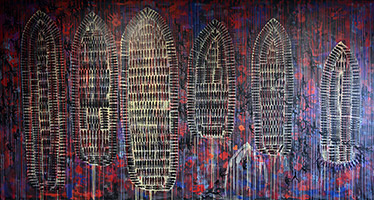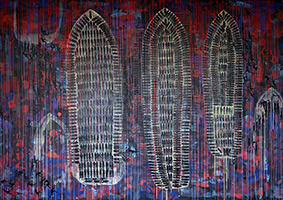
The Galleys of Souls – 1 by OtGO 215x300cm
The Triptych The Galleys of Souls (2013-2021, acrylic on canvas, 215 x 300 cm, 215 x 400 cm, 215 x 300 cm) takes on difficult subject matter that has occupied the artist OtGO in his Berlin studio for several years, namely that of slavery and human trafficking. Despite a continuing lack of visibility and the sense of the ‘taboo’ that such topics garner in mainstream society, these once historically significant issues have become relevant again today, in times when the Black Lives Matter movement in the United States, mass waves of refugee migration in Europe, and the Corona pandemic intensify as political points of contention. In light of this, one must ask again and with much sensitivity: What do slavery and human trafficking truly mean? How is the galley penalty related to it? And in particular, how does OtGO explore these issues through his works and open them up to contemporary discourse?
First of all, a few general words about these terms, which appear to be so closely linked: Since the beginning of mankind, we have been enslaving other humans. Already in antiquity, slaves were thought of economically and by law as ‘unfree‘ and were considered the ‘possessions‘ of other people. Slavery describes this relationship of dependence and is synonymous with laborious, physically draining work. Through the millennia and into today, human trafficking involves the robbery and deportation of people – often to other countries – to be exploited for labour or sexually abused.
Slavery and human trafficking have acquired sad notoriety in world history. This is especially true of the major European maritime powers during the Age of Discovery, which spanned approximately four hundred years following the Middle Ages. First, it was the Portuguese who deported Africans as early as the first half of the 15th century. They exchanged goods for human lives on their shipping voyages and sold these people as slaves. Soon thereafter, the Spanish also engaged in the slave trade. Upon arrival in the New World, they likewise enslaved the indigenous populations of the Americas and the Caribbean. In a third stage, ships brought the raw materials obtained with such 'labour', notably cotton, tea, coffee, tobacco, sugar, and precious metals, from the colonies to Europe. Soon other colonial powers entered the 'flourishing' trade – among others: England, France, Holland, and Denmark. The result was a second wave of millions of West Africans being taken away to colonise the Americas. Only one in four survived the brutal capture and deportation – mostly by their own upper class – and the shipping across the Atlantic. Inhumane conditions prevailed on such vessels: Slaves were squeezed onto the ships, body to body, like pieces of cargo, on and below deck. They were put in chains, mistreated, and left to their uncertain fate without food or medical treatment. The seriously ill were disposed of, without delay, by being mercilessly thrown overboard. The artist OtGO has intertwined the theme of the slave-trading ships with that of the galleys, which were originally known in the ancient world as oar-driven, two-masted warships from the Mediterranean. The galley punishment as atonement meant that convicted criminals were sent to row on such ships, which subsequently often meant death under cruel conditions.
Compositionally, all three large-format paintings of the triptych The Galleys of Souls exhibit a homogeneous structure. Three hulls – and in the larger, central picture, six – are vertically positioned and of differing sizes, dominating the picture field. Although the viewer can easily identify these images as the forms of ships based on the title (galleys), an unbiased perspective, from both a distance and under the lens of abstraction, certainly allows for other ideas: Is the microcosm of organic beings on display here, such as cells and paramecia? Can the leaf structures of tropical plants be discerned on a macro level? Or more artificially thought – are we dealing with Central American fan shapes in the style of Mayan ornamentation? Or the brightly lit windows of a sacred space?

Detailed view: The Galleys of Souls
However, when approaching the pictures, details abruptly tear the viewer out of these harmless chains of associations, and one is confronted with the pictorial theme of slave ships! Upon closer inspection, these ships reveal their interior: silhouettes of bodies lined up in a doomed chain of strict order become recognisable. They are human figures but, like planks, they are forced horizontally and vertically into the shape of the ship. They represent all the human bodies that were crowded together, drastically said, like 'sardines' in the hulls of the ship. Those of them who have already left this terrible ‘order’ on the ships or have been thrown overboard, seem to fly in a wide arc over the ships or to swirl in groups through the sea. Already at this point, the idea of souls – which concerns the second part of the title – becomes understandable. This oppressive effect is reaffirmed on a more formal level by OTGO’s countless blood-red handprints smothering the canvas, and by his distinctive signature – consisting of a thumbprint and vertical lettering, this time in the same blood-red – found at the sterns of each of the ships.




